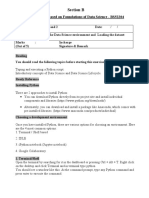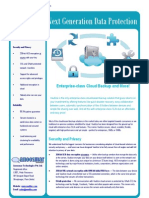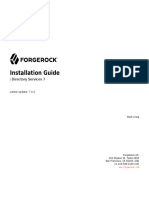0 ratings0% found this document useful (0 votes)
6 viewsAIES Assignment1
AIES Assignment1
Uploaded by
yameenshaikh54Python is a high-level, interpreted programming language that emphasizes readability and simplicity. It has an extensive standard library and rich third-party libraries that enable its widespread use in areas like data science, web development, automation, AI, and more. Key Python libraries include NumPy for numerical processing, Pandas for data manipulation, Matplotlib for visualization, and Seaborn which builds on Matplotlib to provide statistical plots and attractive defaults. These libraries extend Python's capabilities and are essential tools for developers working in various domains.
Copyright:
© All Rights Reserved
Available Formats
Download as PPTX, PDF, TXT or read online from Scribd
AIES Assignment1
AIES Assignment1
Uploaded by
yameenshaikh540 ratings0% found this document useful (0 votes)
6 views15 pagesPython is a high-level, interpreted programming language that emphasizes readability and simplicity. It has an extensive standard library and rich third-party libraries that enable its widespread use in areas like data science, web development, automation, AI, and more. Key Python libraries include NumPy for numerical processing, Pandas for data manipulation, Matplotlib for visualization, and Seaborn which builds on Matplotlib to provide statistical plots and attractive defaults. These libraries extend Python's capabilities and are essential tools for developers working in various domains.
Original Title
AIES_Assignment1
Copyright
© © All Rights Reserved
Available Formats
PPTX, PDF, TXT or read online from Scribd
Share this document
Did you find this document useful?
Is this content inappropriate?
Python is a high-level, interpreted programming language that emphasizes readability and simplicity. It has an extensive standard library and rich third-party libraries that enable its widespread use in areas like data science, web development, automation, AI, and more. Key Python libraries include NumPy for numerical processing, Pandas for data manipulation, Matplotlib for visualization, and Seaborn which builds on Matplotlib to provide statistical plots and attractive defaults. These libraries extend Python's capabilities and are essential tools for developers working in various domains.
Copyright:
© All Rights Reserved
Available Formats
Download as PPTX, PDF, TXT or read online from Scribd
Download as pptx, pdf, or txt
0 ratings0% found this document useful (0 votes)
6 views15 pagesAIES Assignment1
AIES Assignment1
Uploaded by
yameenshaikh54Python is a high-level, interpreted programming language that emphasizes readability and simplicity. It has an extensive standard library and rich third-party libraries that enable its widespread use in areas like data science, web development, automation, AI, and more. Key Python libraries include NumPy for numerical processing, Pandas for data manipulation, Matplotlib for visualization, and Seaborn which builds on Matplotlib to provide statistical plots and attractive defaults. These libraries extend Python's capabilities and are essential tools for developers working in various domains.
Copyright:
© All Rights Reserved
Available Formats
Download as PPTX, PDF, TXT or read online from Scribd
Download as pptx, pdf, or txt
You are on page 1of 15
Introduction to Python Basics
By: Mihir Sutawane (16033923007)
What is Python?
• It is a High-level, interpreted programming language.
• It was created by Guido van Rossum, released in 1991.
• It emphasizes readability and simplicity.
• Python is an interpreted language, which means that code is executed
line by line, making it easy to test and debug. It also supports an
interactive mode, allowing users to experiment with code snippets.
• Python comes with packages for various tasks, such as file I/O,
networking, regular expressions, and more. This reduces the need for
external libraries in many cases.
Python Syntax
1. Indentation-based coding.
2. No curly braces or semicolons.
Example:
#Hello World program
print("Hello, World!")
Variables and Data Types:
3. Dynamically typed variables.
4. Common data types: int, float, str, bool.
Uses of Python
1. Extensive standard library.
2. Rich third-party libraries (NumPy, Pandas, Django, etc.).
3. Widely used in data science, web development, automation, AI and
more.
4. Python, along with libraries like Tkinter, PyQt, and Kivy, is used to
create desktop GUI applications.
5. Python is a dominant language in the field of machine learning and
artificial intelligence. Frameworks like TensorFlow, PyTorch, and
scikit-learn enable the development and deployment of machine
learning models.
Python ToolKits
• In Python, toolkits are libraries or collections of modules that provide
pre-built functions and classes to facilitate specific tasks or solve
particular problems. These toolkits cover a wide range of domains,
from web development to data science, machine learning, and more.
• Python toolkits can be thought of as sets of tools that extend the
capabilities of the Python programming language. They are often
created to address specific needs or to provide efficient solutions to
common challenges in different fields.
• These toolkits are essential for developers as they allow them to
leverage existing code and functionalities, saving time and effort in the
development process.
Numpy
• Numpy is a general-purpose array-processing package. It
provides a high-performance multidimensional array object, and
tools for working with these arrays.
• Besides its obvious scientific uses, Numpy can also be used as
an efficient multi-dimensional container of generic data.
• NumPy is a fundamental library for scientific computing in
Python and serves as a foundation for many other libraries and
frameworks in the data science and machine learning
ecosystems.
• N-dimensional Arrays: NumPy introduces a new data structure called ‘ndarray
‘(n-dimensional array), which is a fast and flexible container for large datasets.
These arrays can be one-dimensional, two-dimensional, or even higher-
dimensional.
• Linear Algebra Operations: NumPy includes a comprehensive set of linear
algebra operations, such as matrix multiplication, decomposition, and solving
linear equations. These functionalities are crucial in various scientific and
engineering applications.
• Indexing and Slicing: NumPy provides powerful indexing and slicing
capabilities, allowing users to access and manipulate specific elements or
subsets of arrays efficiently.
• Integration with Other Libraries: NumPy is often used in conjunction with other
libraries, such as Pandas for data manipulation, Matplotlib for data visualization,
and Scikit-learn for machine learning.
Pandas
• Pandas is a powerful and widely-used open-source data manipulation
and analysis library for Python.
• Pandas is particularly well-suited for working with structured data
and is an essential tool in the toolkit of data scientists, analysts, and
engineers.
• It is built on the top of the NumPy library which means that a lot of
structures of NumPy are used or replicated in Pandas.
• Well suited for working with tabular data, such as spreadsheets or
SQL tables.
• DataFrame: The DataFrame is a two-dimensional, labeled data
structure with columns that can be of different types (e.g., integers,
floats, strings). It is similar to a spreadsheet or SQL table, making it
convenient for handling and analyzing structured data.
• Data Cleaning: Pandas provides functions for handling missing data,
removing duplicates, and transforming data. This is crucial for
preparing data for analysis.
• Data Exploration: Users can easily explore and summarize data using
descriptive statistics, aggregations, and visualization tools. Pandas
integrates well with other visualization libraries like Matplotlib and
Seaborn.
• Data Selection and Indexing: Pandas allows for flexible and powerful
indexing and selection of data based on labels, positions, or boolean
conditions. This makes it easy to filter and subset data.
• GroupBy Operations: Pandas supports grouping data based on one or
more keys and performing operations on each group independently.
This is useful for aggregating and summarizing data.
• Merging and Joining: Pandas provides functions to merge and join
DataFrames based on common columns or indices, similar to SQL
operations.
• Time Series Functionality: Pandas has robust support for working
with time series data, including date/time indexing, resampling, and
time-based calculations.
Matplotlib
• Matplotlib is a comprehensive 2D plotting library for Python that
enables users to create a wide range of high-quality static
visualizations.
• Matplotlib is widely used in various scientific disciplines, data
analysis, and engineering for creating plots and charts to visualize
data and present results.
• Matplotlib consists of several plots like line, bar, scatter, histogram,
etc.
Some of the sample plots are covered here.
Seaborn
• Seaborn is a visualization library for statistical graphics plotting in
Python.
• It provides beautiful default styles and color palettes to make statistical
plots more attractive.
• It is built on top matplotlib library and is also closely integrated with
the data structures from pandas.
• Seaborn aims to make visualization the central part of exploring and
understanding data.
• It provides dataset-oriented APIs so that we can switch between
different visual representations for the same variables for a better
understanding of the dataset.
1. Statistical Plotting: Seaborn includes several functions for creating
statistical plots that are not easily achievable with Matplotlib alone.
2. Attractive Aesthetics: Seaborn comes with visually appealing default
styles and color palettes.
3. Built-in Themes and Color Palettes: Seaborn provides various built-
in themes and color palettes, allowing users to quickly change the
overall appearance of their plots.
4. Support for Categorical Data: Seaborn excels at handling categorical
data, making it easy to create plots that display relationships between
variables, especially when one or more variables are categorical.
5. Facet Grids: Seaborn supports facet grids, which allow users to
create a grid of subplots based on the values of one or more
variables.
THANK YOU
You might also like
- Az 9000 July DumpsDocument174 pagesAz 9000 July Dumpsdhanalakshmi k sNo ratings yet
- Python For Data ScienceDocument20 pagesPython For Data ScienceEric IchauraNo ratings yet
- 2 IntroPythonDocument22 pages2 IntroPythonTanvi sharmaNo ratings yet
- Ds Module 1Document72 pagesDs Module 1Prathik SrinivasNo ratings yet
- Python Libraries Seminar ReportDocument16 pagesPython Libraries Seminar ReportDrishti Gupta100% (2)
- DDI Book Chapter Tools and TechniquesDocument13 pagesDDI Book Chapter Tools and TechniquesMuhammad AteeqNo ratings yet
- Training Report On Data Science With PythonDocument9 pagesTraining Report On Data Science With Pythonvikaskumar1atozNo ratings yet
- Exp1mlDocument6 pagesExp1mlJui BhanushaliNo ratings yet
- Python For Data ScienceDocument8 pagesPython For Data SciencefdwadjitazmncwgwuwNo ratings yet
- What Is Python?: Why Python For Data Science?Document3 pagesWhat Is Python?: Why Python For Data Science?sabari balajiNo ratings yet
- Machine Learning Lecture2Document38 pagesMachine Learning Lecture2xavieranosikeNo ratings yet
- Data Science ToolsDocument2 pagesData Science ToolsAbhijit BhatyeNo ratings yet
- Python LibrariesDocument12 pagesPython LibrariesDiego RodríguezNo ratings yet
- 8 LO5 Lect 1Document16 pages8 LO5 Lect 1Ali Azgar KathaNo ratings yet
- MarketingDocument3 pagesMarketingvatsala mishraNo ratings yet
- Anshika Summer TrainingDocument11 pagesAnshika Summer Trainingbit21ec21No ratings yet
- Python Quick NotesDocument2 pagesPython Quick NotesSAUMYA GOELNo ratings yet
- 0-Ip Project NewDocument29 pages0-Ip Project Newkuwarkalra.10No ratings yet
- Machine Learning Python PackagesDocument9 pagesMachine Learning Python PackagesNandkumar KhachaneNo ratings yet
- MGNM801 Ca2 FinalDocument13 pagesMGNM801 Ca2 Finalastitvaawasthi33No ratings yet
- Python LibrariesDocument17 pagesPython Librariessaivishnukandur2006No ratings yet
- Python For Data AnalysisDocument4 pagesPython For Data AnalysiscodewithtushpatNo ratings yet
- Data Science Using With PythonDocument14 pagesData Science Using With Pythonsuji myneediNo ratings yet
- Pre ML PractiseDocument14 pagesPre ML Practisebpkdeveloper45No ratings yet
- Simple Libraries in PythonDocument12 pagesSimple Libraries in Pythonsuriya prabhaNo ratings yet
- Python BasicDocument145 pagesPython BasicMᴏsᴇs MJNo ratings yet
- Chapter - 2: Data Science & PythonDocument17 pagesChapter - 2: Data Science & PythonMubaraka KundawalaNo ratings yet
- T - Report Abhishek ChoudaryDocument17 pagesT - Report Abhishek ChoudaryRaj SinghNo ratings yet
- Python Data Mastery ReportDocument9 pagesPython Data Mastery Reportompandey4013No ratings yet
- PythonDocument3 pagesPythonSubid BiswasNo ratings yet
- Introduction-It SkillsDocument20 pagesIntroduction-It Skillsraiyanishubham8133No ratings yet
- Visualization - Python Data AnalysisDocument13 pagesVisualization - Python Data AnalysisMichael GbonehNo ratings yet
- Python Machine Learning - Session 2Document6 pagesPython Machine Learning - Session 2Pace InfotechNo ratings yet
- Module03-Introduction To PythonDocument40 pagesModule03-Introduction To Pythonefeerer582No ratings yet
- Basic Libraries For Data ScienceDocument4 pagesBasic Libraries For Data SciencesgoranksNo ratings yet
- CH 4Document17 pagesCH 4parubansal918No ratings yet
- PythonDocument12 pagesPythonRakshitNo ratings yet
- Unit 5 PythonDocument10 pagesUnit 5 PythonVikas PareekNo ratings yet
- Data MungingDocument65 pagesData Mungingba22samyukthaNo ratings yet
- Pt. L R Group of Institutions Faridabad Delhi NCRDocument21 pagesPt. L R Group of Institutions Faridabad Delhi NCRfrodykaamNo ratings yet
- UntitledDocument61 pagesUntitledJyothi PulikantiNo ratings yet
- Unit Ii Getting Started With PandasDocument35 pagesUnit Ii Getting Started With PandasT. SruthiNo ratings yet
- Program Name: B.Tech Semester:6TH Course Name: Course Code: Facilitator Name:ANTIM PANGHALDocument13 pagesProgram Name: B.Tech Semester:6TH Course Name: Course Code: Facilitator Name:ANTIM PANGHALŁĘGÈÑĐ GĀMĮÑGNo ratings yet
- Session3 - Analytics For Programming II - Siryani - 090524Document28 pagesSession3 - Analytics For Programming II - Siryani - 090524berkeal260No ratings yet
- PYTHONDocument11 pagesPYTHONsuheylayakupoglu5No ratings yet
- Sample of CS 1Document40 pagesSample of CS 1harshiiiii352No ratings yet
- 40 Most Popular Python Scientific LibrariesDocument9 pages40 Most Popular Python Scientific LibrariesGaurav SinghNo ratings yet
- Python BasicDocument6 pagesPython Basicbizzpy nNo ratings yet
- Data TyDocument59 pagesData TyInaara RajwaniNo ratings yet
- PythonDocument3 pagesPythonvatsala mishraNo ratings yet
- 0901ec221090 RishavmudgalDocument11 pages0901ec221090 RishavmudgalSuryanshNo ratings yet
- Future For Scientific Computing Using PythonDocument7 pagesFuture For Scientific Computing Using PythonSaraswathi ANo ratings yet
- DSBDA Lab ManualDocument155 pagesDSBDA Lab Manualharsh.sb03No ratings yet
- DSLab2020 - Week 1 ExercisesDocument30 pagesDSLab2020 - Week 1 ExercisesAliss uchihaNo ratings yet
- Module 4 - Writing Functions in PythonDocument20 pagesModule 4 - Writing Functions in PythonuzairNo ratings yet
- Main PART PDFDocument46 pagesMain PART PDFIshan PatwalNo ratings yet
- Handout 1 - Introduction To Setting Up PythonDocument49 pagesHandout 1 - Introduction To Setting Up PythonkavithaNo ratings yet
- PythonDocument23 pagesPythonManish GoyalNo ratings yet
- Python Data Analysis: Transforming Raw Data into Actionable Intelligence with Python's Data Analysis CapabilitiesFrom EverandPython Data Analysis: Transforming Raw Data into Actionable Intelligence with Python's Data Analysis CapabilitiesNo ratings yet
- Python Machine Learning for Beginners: Unsupervised Learning, Clustering, and Dimensionality Reduction. Part 2From EverandPython Machine Learning for Beginners: Unsupervised Learning, Clustering, and Dimensionality Reduction. Part 2No ratings yet
- Vaultize Data SheetDocument4 pagesVaultize Data SheetVaultizeNo ratings yet
- NBU Appliance CapacityDocument151 pagesNBU Appliance CapacitymohantysNo ratings yet
- DS 7 Install GuideDocument75 pagesDS 7 Install GuideJUAN JESUS SALAZAR JACOBENo ratings yet
- PDF Nmap Tutorial PDF - CompressDocument20 pagesPDF Nmap Tutorial PDF - CompressAdem SylejmaniNo ratings yet
- IndusInd Bank Credit Card Bill PaymentsDocument2 pagesIndusInd Bank Credit Card Bill PaymentspritamjaanNo ratings yet
- Policies - KubernetesDocument21 pagesPolicies - KubernetesFantahun FkadieNo ratings yet
- Post No 6 - How To Move Your Website From Localhost To Online ServerDocument7 pagesPost No 6 - How To Move Your Website From Localhost To Online ServerrpshvjuNo ratings yet
- Docker Workshop 1Document29 pagesDocker Workshop 1yopogi4686No ratings yet
- Enterprise Resource Planning - Erp: Muhammad AliDocument16 pagesEnterprise Resource Planning - Erp: Muhammad AliBenjamin adeelNo ratings yet
- CW1-Company AnalysisDocument9 pagesCW1-Company AnalysisLee Hao HuiNo ratings yet
- CM1603 FinalDocument14 pagesCM1603 Finaleshensanjula2002No ratings yet
- IG 4100 Product Data Sheet - r1 - 6Document2 pagesIG 4100 Product Data Sheet - r1 - 6Mohamad Zahir SaadNo ratings yet
- Database Management Systems Lab CSE2004: FAT Lab Examination - DEC 2021Document6 pagesDatabase Management Systems Lab CSE2004: FAT Lab Examination - DEC 2021HARSHENEE CB 20BRS1179No ratings yet
- BSN 1b-Student-Information-SheetDocument5 pagesBSN 1b-Student-Information-SheetSALGIE SERNALNo ratings yet
- SOL5379 - Overview of HTTP Compression and Chunked ContentDocument2 pagesSOL5379 - Overview of HTTP Compression and Chunked ContentMahmoudAbdElGhaniNo ratings yet
- 4 Azure Considerations To Reduce CostsDocument12 pages4 Azure Considerations To Reduce Costsramarbstr12playNo ratings yet
- Crime MappingDocument13 pagesCrime MappingLOVELY TRAZONANo ratings yet
- Blueprint Inventory - Teepham Medical Sdn. BHDDocument17 pagesBlueprint Inventory - Teepham Medical Sdn. BHDirhamazmiNo ratings yet
- IE-121 Introduction To IE Systems & MetricsDocument17 pagesIE-121 Introduction To IE Systems & MetricsLahm NguyNo ratings yet
- Sumatra, Ferraris, Garrido - Tsa2Document13 pagesSumatra, Ferraris, Garrido - Tsa2Rome SumatraNo ratings yet
- SQL QuestionsDocument11 pagesSQL QuestionsKeshav WaghmodeNo ratings yet
- DHL Tech StackDocument1 pageDHL Tech StackShashank VijayvergiaNo ratings yet
- Y10 - 04 - P21 - Activities 1111Document2 pagesY10 - 04 - P21 - Activities 1111alazario26No ratings yet
- Doctor Appointment PortalDocument104 pagesDoctor Appointment PortalMohamed Ahmed AbdiNo ratings yet
- Nextiva Term and ConditionDocument12 pagesNextiva Term and Conditionhoangtunght0182No ratings yet
- Oracle Database - System Identifier (SID) (Gerardnico)Document2 pagesOracle Database - System Identifier (SID) (Gerardnico)shuvo_ami24100% (1)
- Inpqs Digitally Transforming Specification in The Construction IndustryDocument15 pagesInpqs Digitally Transforming Specification in The Construction IndustryAngie Siok Ting LimNo ratings yet
- ML16019A308 - BTP 7-14 - Software Reviews For Digital Computer Based I - CDocument75 pagesML16019A308 - BTP 7-14 - Software Reviews For Digital Computer Based I - CsuzanaksoyNo ratings yet
- Comptia It Fundamentals+ (Exam Fc0-U61) : Module 5 / Unit 1 / Security ConcernsDocument18 pagesComptia It Fundamentals+ (Exam Fc0-U61) : Module 5 / Unit 1 / Security ConcernsDon Erick BonusNo ratings yet

























































































